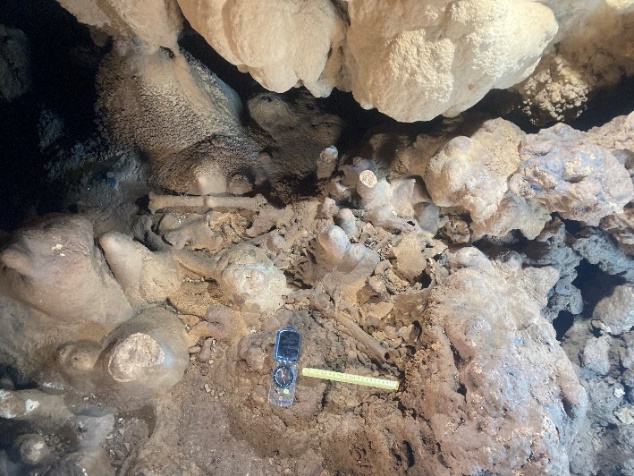〇Ryosuke KIMURA (University of the Ryukyus), Masatoshi MATSUNAMI (University of the Ryukyus), Masami TAKENAKA (Kagoshima Women's Junior College), Shinji YAMAZAKI (University of the Ryukyus, Okinawa Prefectural Museum & Art Museum)
1. Survey of archaeological sites
1-1. results of the ixayo cave site (okinoerabu island) survey (takenaka: conducted in August, October, and November 2023, and January and March 2024)
The eastern end of the sarcophagus was detected in the research area of the sea cliff side cave mouth, which had been excavated until the previous fiscal year.
This year's survey revealed the entire upper part of the sarcophagus.
In August 2023, a re-interment grave (grave 2023-1) was discovered in a limestone fissure (Figures 5 and 6), and in October, new pottery shards, ancient human bone fragments, and processed luminous shells were found at the entrance of the cave mouth on the Yota River side. In the November survey, the upper part of the cave was examined to confirm the present condition of grave 2023-2. 2023-2 contains a large number of human remains under a large stone. Human bone fragments were found on the large stone and in the surrounding limestone hollows (Figures 14 and 15). Pottery shards were also observed. A burial facility in which human bones and bamboo shell products were placed beside the large stone and artificially piled on top of the limestone was also identified.
1-2. Results of the Wanyakawahara Site (Tokunoshima) Survey (Takenaka: conducted in December 2023)
Three trenches were newly set up and excavation began; in trench 2, a large shell midden was found along with claw-shaped pottery shards; in trench 3, reinterred human bone fragments and shell products were excavated along with pottery shards dating to the Late Jomon to Yayoi Period equivalent;
1-3. Excavation of the Ikejima Kulkargama site (Yamazaki: conducted from December 13, 2023 to January 12, 2024)
A group of human bones accompanied by well-preserved furnace sites and holacaustic shells, which are believed to be from the shell mound period, were detected.
1-4. Field survey of the Ishikawa Teraabudo Site, Motobu Town (Yamazaki: conducted from March 2, 2024 to March 3, 2024)
Radiocarbon dating of human bones collected from the site revealed that the bones are estimated to be approximately 3,000 years old or older, and are noteworthy for containing numerous well-preserved partial bones and individual skeletons incorporated into calcareous materials.
1-5. Survey of prehistoric sites and caves in Tarama Village (Yamazaki: conducted from February 16, 2024 to February 20, 2024)
In the sand dune area in the northern part of the village, an inclusion layer site consisting of a black sand layer dated to about 2,500 years ago, which is estimated to be from the Earthenware Culture period, was prospected and non-local quartz was recovered along with pottery stones, marine shells, and fish bones. We also investigated an ancient grave (Yamatotumbara) in a cave formed in the lower part of an isolated rock mass in the northwestern part of the site, and confirmed a large number of human bones that appear to be from the medieval to early modern periods.
1-6. Volcanic Ash Archaeological Survey on Extensive Volcanic Ash in the Ryukyu Islands (Yamazaki)
As part of the survey, volcanic ash analysis was conducted at the Sakitari-do site and the Yoron Island Yori site. From volcanic glass ratio analysis and refractive index measurement of volcanic glass, we were able to detect volcanic glass that can be presumed to be AT volcanic ash.


2.Genome analysis
2-1. Whole Genome Analysis of Modern Ryukyu Islanders (Kimura & Matsunami)
Whole genome analysis was conducted on 25 individuals from Iriomote and Yonaguni Islands (all four grandparents were from those islands). The whole genome data of more than 400 people from the modern Ryukyu Islands, which have been accumulated over the years, were used to analyze the whole genomes of these individuals. Using these data, we are reconstructing the population history of each island in the Ryukyu Archipelago and comparing it with the following ancient human genome data. In addition, we have been searching for gene polymorphisms related to the remaining frontal suture.
2-2. Genome Analysis of Ancient Humans in the Ryukyu Islands (Matsunami & Kimura)
We conducted an integrated analysis of 274 modern human genomes collected in the Ryukyu Archipelago and 25 ancient human genomes estimated to originate from the shell midden period (6,700-900 years ago) based on excavation data. qpWave and qpAdm analyses indicate that the North Ryukyu Islanders (Okinawa and Amami Islands) of the shell midden period have a diverse mixed blood ratio with the Jomon people, while the Southern Ryukyu Islanders (Miyako and Yaeyama Islands) of the Eoless Period (2,500-900 years ago) were suggested to be heavily influenced by the mainland Jomon people. Thus, it is inferred that prehistoric Ryukyu Islanders were genetically diverse, and that at least two human migrations from the mainland to northern Ryukyu after the Jomon period were important in the formation of their population genetic structure.
